The Best Front-end Frameworks for Web Development in 2021
Programming websites and web apps should always start with choosing the right technology. This will, in fact, become the basis of your future project. Whether you are new to programming or have already discovered your path, perhaps you work with JavaScript. If so, you should never forget about JavaScript frontend frameworks. Coders use them all the time, as they are the perfect tools for developing advanced web applications.
In the following article, we emphasize the top frontend frameworks over the past few years. More than that, we have managed to analyze a ton of information regarding JS trends. All this to choose the ones that will maintain or increase their popularity among coders. What you will find here are only the very best front end JavaScript frameworks.
Angular, React, Vue – these names are widely known to all programmers. But the question is, are they good at all? Or maybe just overrated? Stay with us to discover all pros and cons of the mentioned frameworks plus a lot more.
The popularity of frameworks over the past 5 years
Over the past 5 years, the popularity of JS front end frameworks has been increasing steadily. Interestingly enough, by the end of each year, the demand has dropped rapidly. Only to bounce back in January.

These repeatable massive drops are clearly visible on Google Trends. The same thing happened in December 2020 as well. Over the past few years, Google users have kept searching for React.js the most. Angular has always been just a small step behind, with Vue.js coming in third.
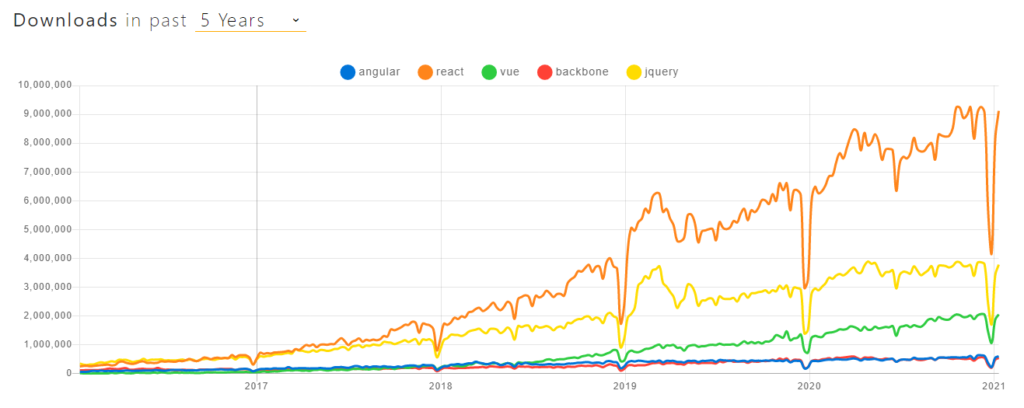
To confirm our Google findings, we went to NPM Trends for JS front end frameworks downloads. The same popularity drops were visible. The website shows that React.js is the most commonly downloaded framework. The second place belongs to jQuery. Vue.js falls right behind.

Looking at State of JS, you will see a compelling outcome. This widely respected JS-only development survey leads us to the conclusion, that React maintains a high reputation among programmers. It was the most trustworthy JavaScript frontend framework each year. Except for that one time in 2018, when it shared first place with Vue.js. To our surprise, Angular’s prominence among users has been consequently dropping lately.

Statista has surveyed developers online around early 2020 to study web framework popularity. Among the most used JS front end frameworks we can see jQuery, React.js, and Angular. Nothing too surprising, to be honest.
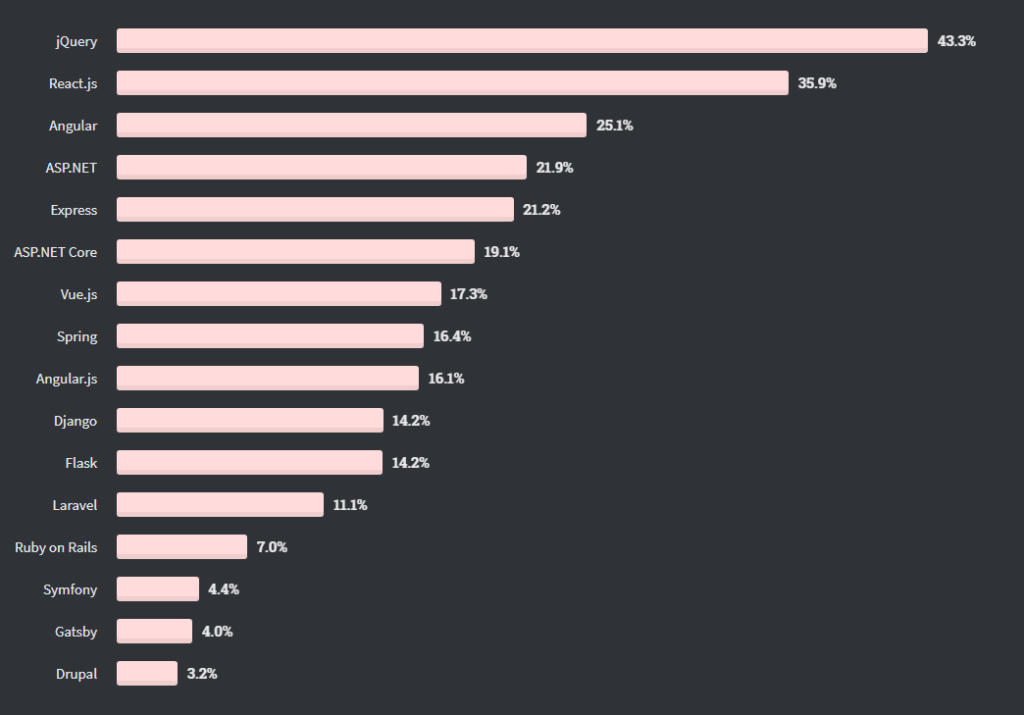
To confirm the questionnaire, we looked at StackOverflow and their insights for developers in early 2020. They came with results very similar to the ones from the Statista website.
This brings us to a final verdict. The popularity of the best front-end JavaScript frameworks changes. Still, the ones that maintained their reputation over the last five years are Angular, React, and Vue.js.
List of Frameworks That Will Be Popular in 2021
We want to share with you our predictions about the top trends in JavaScript frontend frameworks for 2021. There are a few frameworks that will surely maintain their position. Based on the analysis of the previous years and popularity changes, here is our shortlist for this year:
- React.js
- Angular
- Vue.js
- Backbone
- Ember
Looking at current trends, we understand that the JS front end frameworks environment is flourishing. We also want to share a light at a handful of useful frameworks, which will still be in use in 2021. Even though their prime time is gone:
- Ext JS
- Svelte
- Preact
Stay with us if you want to know more about the top front end frameworks for 2021.
Top 5 JavaScript Frontend Frameworks in 2021
Let us take a closer look at all the main features of the best front end JavaScript frameworks. After a detailed study, we have handpicked a choice of 5 prime frameworks for you.
1. React
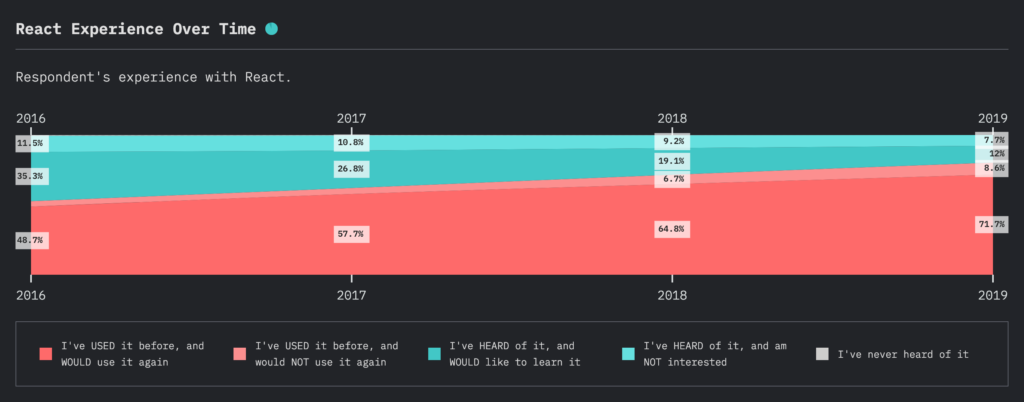
Over 162K stars on GitHub make React.js really trustworthy. This open-source JavaScript frontend framework saw the light of the day in 2013. It happened thanks to Facebook. The framework was designed to let designers and developers create modern graphical app interfaces. React.js uses components that greatly improve the whole process of building a web project. Thanks to its high efficiency, this JS framework is perfectly suitable for high traffic applications. Like Netflix, Dropbox, or Pinterest, which all are based on React.js.
React.js – the most important features:
- This front end framework works quicker than others. Thanks to that programmers can save a lot of time and become more efficient.
- Compared to Angular, React’s productivity has been constantly increasing, becoming a tool for creating serious and complex software.
React.js pros:
- Good performance as it is based on a virtual DOM.
- Its components can be reused in different parts of an app.
- A large community constantly developing and making the framework stable.
- It is versatile and can be used with any framework.
- One-way data flow.
React.js cons:
- The use of complex JSX makes developers and designers complain about it.
- Its dynamics can sometimes affect Google Search Engine Optimization (SEO).
- Supports frontend results alone.
2. Angular
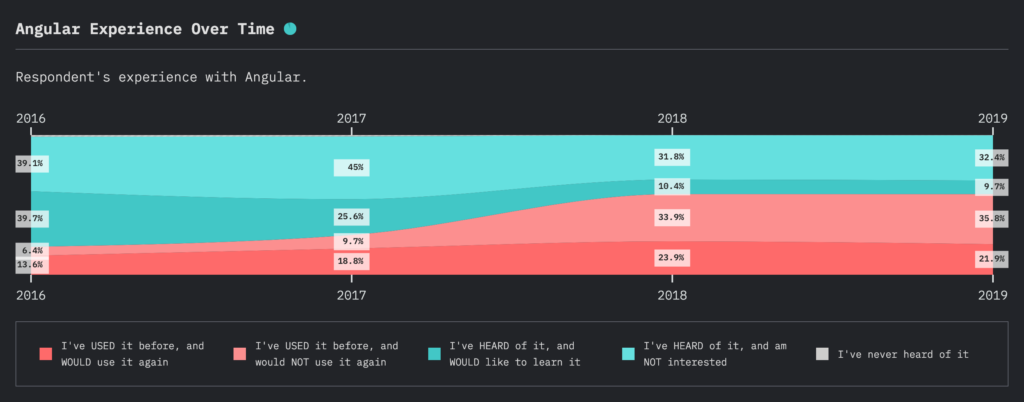
Angular is a JavaScript front-end framework for web apps created by Google engineers. They aimed to totally revolutionize the designs within front end web applications. Did they succeed? Well, if we look at its popularity and reputation, we can say Angular has surpassed its older colleague, jQuery. Xbox, Forbes, and BMW apps are based on this technology. All programmers who use this framework learn good practices. Along with React.js, Angular is widely recommended for beginners. But is it really that easy?
Angular – the most important features:
- This framework uses two-way data binding. It ensures dynamic data synchronization between the view layer and the data model layer within the MVW architecture.
- Angular is built exclusively on TypeScript, which provides a smooth and effective experience. In other words, TypeScript is Angular’s primary language.
- It is a cross-platform framework. Using Angular, programmers can create websites, web apps, mobile apps, and desktop apps. Pretty neat, huh?
Angular pros:
- It automatically catches changes within the model layer, modifying the HTML code on its own.
- Simple testing solutions based on Angular supports the integration of unit tests.
- Dependency Injection enables easy transfer and collaboration between all components within a complex system.
- Angular works perfectly with outside libraries like jQuery, UnderscoreJS, or Ionic framework.
- The built-in REST communication via $http and $resource
Angular cons:
- Difficult to learn complicated processes. It is not the easiest framework for beginners who have no experience with JavaScript and TypeScript.
- All scripts are being loaded at the same time when you open the app. It affects the programmers’ efficiency and work speed.
- For full website indexation, you will need to use external tools, which return the correct HTML code.
3. Vue.js
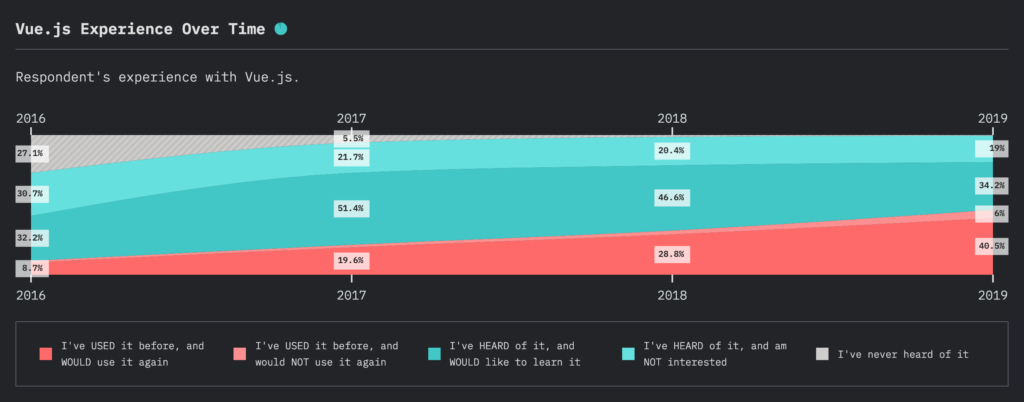
When it comes to Vue.js, the introduction should not be necessary. This open-source MVV model JavaScript frontend framework was first introduced in 2014 by Evan You. He used to work at Google, where he was using Angular. At first, You created a lightweight version of what he liked most about Angular’s environment. Now, seven years later, Vue.js is one of the world’s most commonly used JS front end frameworks. But can it live up to its reputation?
Vue.js – the most important features:
- It works like an all-in-one JavaScript frontend framework, combining the most amazing tools from Angular, React, and Ember. And it is more lightweight than its predecessors.
- This framework works on a virtual DOM and uses the two-way binding. All this makes Vue.js a sophisticated and modern solution for developing complex web apps.
- Vue.js is based on open-source and is likely to become more user-friendly. Especially because of the detailed and extensive documentation for all programmers.
Vue.js pros:
- Server-based rendering based on what Angular2 and React provides.
- Speed and efficiency for both single-page and multi-page projects.
- Intuitive functions and easy syntax make this framework easy to learn for beginners.
- Supports elastic and flexible programming based on a clear and readable code.
- Backs the use of Typescript.
Vue.js cons:
- Little support. There is no major corporation behind Vue.js. Which makes it a lesser choice for advanced coders who are used to other JavaScript frontend frameworks.
- Flexibility. Do not get us wrong. It is also an advantage of Vue.js. But at the same time, the multitude of component choices can cause problems. Especially during the implementation of a large-scale project with many programmers working on it.
- Language barrier. Many of the new mechanisms and plugins, used in Vue.js, are written in Chinese.
4. Backbone
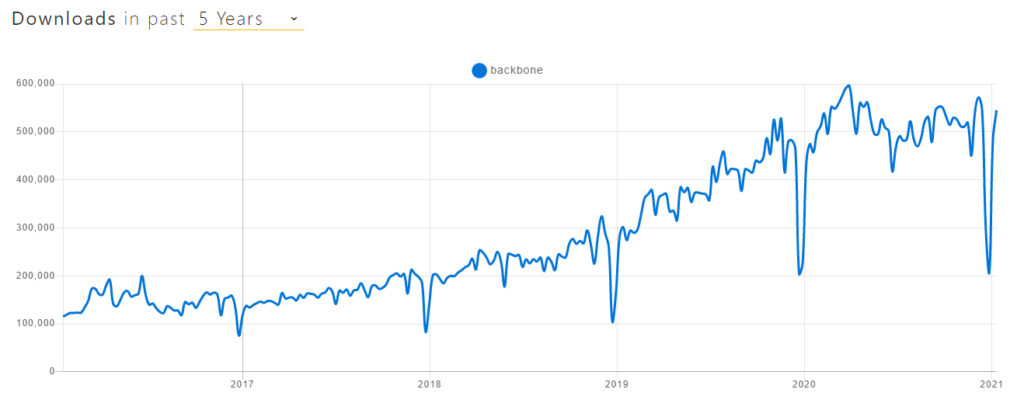
Backbone.js is yet another stable JavaScript frontend framework for web apps. It was released in 2010. Its creator, Jeremy Ashkenas, is also known for CoffeeScript and Underscore.js. This lightweight JS framework is handled by the MVC model. It is designed to serve developers working on single-page web applications. Backbone.js is used widely and its popularity increases each year. Web apps built on this framework include, among others, Airbnb, Hulu, SoundCloud, or Verizon.com.
Backbone.js – the most important features:
- Being easy to learn, this frontend framework lets programmers develop client-sided web apps and mobile apps.
- It adopts an imperative programming paradigm when working with the DOM. In other words, Backbone consists of commands for the apps to perform.
- Backbone.js is compatible with REST API, making it flawless to synchronize between backend and frontend framework uses.
Backbone.js pros:
- Provides fast and smooth operations.
- Very easy for beginners to learn this frontend JavaScript framework for web apps.
- Based on an open-source library, it has more than 100 user-made working extensions.
- Its models and collections are compatible with RESTful architecture. You can conveniently retrieve their data from the server.
- Very responsive. All changes to the code can be visible within the app right away.
Backbone.js cons:
- To write more complex apps, programmers need to download additional plugins and extensions.
- Light size. It is an advantage at the same time. Yet, if you want to use Backbone.js to the fullest, you need to add Underscore.js and jQuery frameworks to your project.
- Backbone.js does not have any readymade structures. It only has some very basic tools for designing the application’s layout.
5. Ember
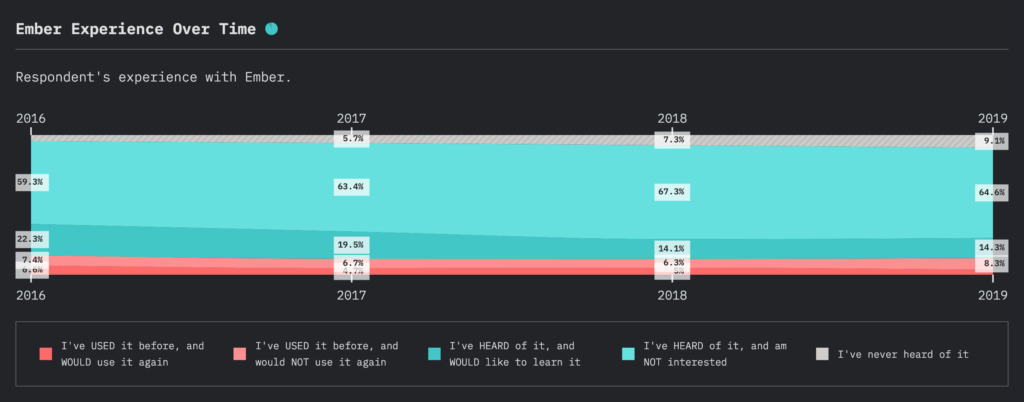
Another widely used and well-known JavaScript frontend framework is Ember.js. Created in 2011 by Yehuda Katz, it is highly recommended by professional coders, working on advanced solutions. An engaged community is behind this framework, as it is based on open-source mechanisms. Ember.js focuses on providing the highest quality tools for client-side web apps and mobile apps. Right now, some of the most notable websites, using this framework, include Apple Music, Discourse, LinkedIn, and Twitch.
Ember.js – the most important features:
- Two-way data binding, just like in Angular.js. This feature synchronizes both the model and the view.
- Having Fastboot.js on hand makes all server-side DOM rendering fast and improves complex interface performance.
- Ember.js is just one of the main components of a complex frontend stack prepared by the Ember team. These solutions also include Ember CLI, Ember Data, Ember Inspector, Fastboot, and Liquid Fire.
Ember.js pros:
- It uses easy-to-follow templates, allowing for simple and flexible UI development.
- Thanks to this framework, you can add nesting routes on the top of a template view.
- Easy debugging thanks to the Ember Inspector solutions.
- Users get good documentation regarding the JS frontend framework.
- All templates used can be compiled within a server beforehand.
Ember.js cons:
- Learning the framework is considered to be difficult. Ember.js is recommended to advanced users, who know their way around JS front end frameworks.
- It does not use simple JavaScript models, making web apps more complex than in the case of Angular.js.
- There is a relatively smaller community behind Ember.js. Therefore, finding solutions to your problems may take a bit more time.
Overview of Other Frameworks
We have chosen three other JS frontend frameworks that are worth mentioning. Even if they are not as popular as the ones we mentioned before. Let us have a quick look at them.
1. Ext JS

Ext JS, a frontend JavaScript framework for web apps, was introduced in 2007. It was first built as a YUI add-on library extension. The use of external frameworks with Ext JS is optional. This technology can work totally independently. It may not be the most popular frontend framework but it works pretty well. Especially when creating dynamic grids for static webpages or developing single-page web apps.
Pros of Ext JS:
- Uses a lot of widgets, becoming easy to operate and implement changes.
- There is a reliable community, providing good documentation and tutorials. It makes this framework an interesting option for beginner programmers.
- Users can take advantage of a stable base of pre-tested UI components.
Cons of Ext JS:
- Ext JS free version has limited user support and users might have issues with debugging.
- The full version is quite expensive. Therefore we only recommend it to users who are sure they will keep on working with this framework.
2. Svelte
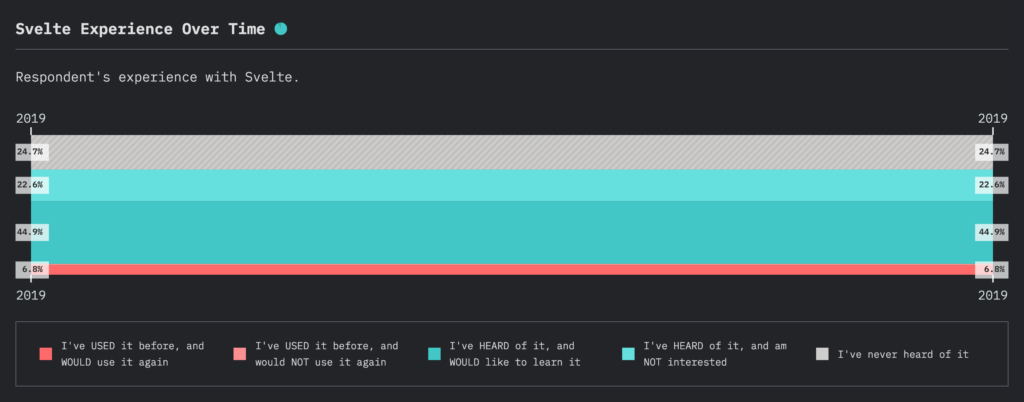
Svelte is a relatively young JavaScript front end framework, based on its predecessor, Reactive.js. The first version of this free and open-source framework was released in 2016. Programmers can use Svelte directly in the browser, which is an innovation in comparison to its competition. Due to being one of the latest JS frontend frameworks out there, it still lacks an integrated community. Maybe it is going to change in the years to come. We shall watch it carefully.
Pros of Svelte:
- Lightweight and therefore faster than other frontend frameworks.
- It helps to scale down a web app by reducing its size. This is a great opportunity for all heavyweight applications not working correctly on slower Internet connections.
- The components are easy to grasp and their responsiveness to labelled statements works very well.
Cons of Svelte:
- There is a small (but constantly growing!) community behind the framework. It becomes difficult to solve some issues beginner coders may have when learning this library.
- It is recommended to use Svetle for smaller projects. There are still not enough additional tools available to help coders work on a big scale.
3. Preact
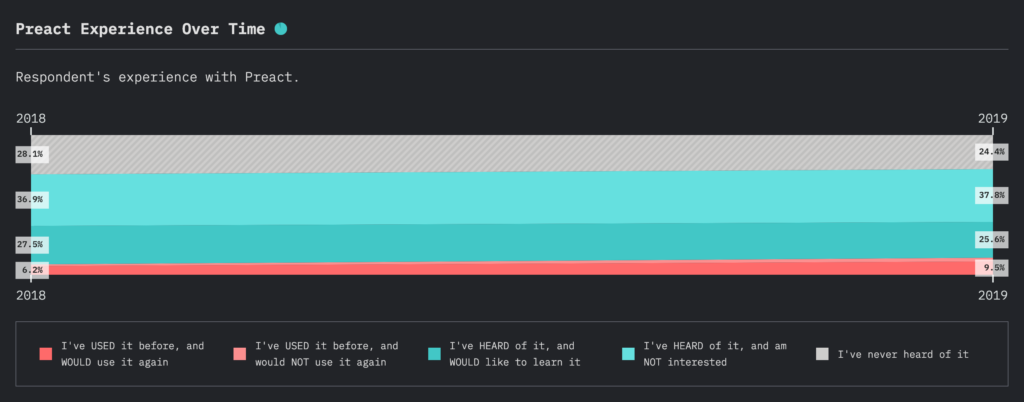
At first, you may confuse Preact with React. However, the first framework is a lot lighter and faster. Switching to Preact is a good idea for all developers working in JavaScript. Using this frontend framework will definitely make all web apps be more responsive and work quicker. There is also a downside to it. You can lose a handful of React’s features. Will Preact ever be as popular as other frameworks? At this point, it is difficult to say.
Pros of Preact:
- Lightweight, portable, and compatible with React libraries.
- High efficiency lets coders perform seamlessly and create lighter versions of web apps.
- It has more functions than React-lite framework.
Cons of Preact:
- A small community makes it more difficult to receive solutions to some problems.
- Only stateless functional components and an ES6-dependent component are provided by Preact.
Which JS Frontend Frameworks to Learn in 2021?
So you are about to learn a new JavaScript frontend framework in 2021? Then you should ask yourself what is it you want to achieve. Find your goal and then look for means to fulfil your aim. There are a few wonderful frameworks for beginners who have no previous experience with JavaScript. The best front end JS framework to start with is React.js. Thanks to a prominent community of users, beginners will find it easy to look for solutions to issues.
Advanced coders should challenge themselves and keep on putting the bar higher. That is why we want to recommend all the newcomers. What we have in mind are all the top front end frameworks that do not have a great community and are not used by beginner coders. Why is that? Because such technologies, as Preact, Svetle, and Ext JS need professionals to help future programmers solve existing problems.
Which JS Frontend Framework to Choose for Developing Your Project in 2021?
When you consider yourself a professional JavaScript user, there are no limitations regarding the frameworks you can trust. If you search for the best JS frontend framework for designing and developing your big-scale project, choose Angular. It is going to be one of the highly supported JS developments in 2021. Your work can be much simpler and faster than ever, due to the use of TypeScript.
Another wonderful idea is to give Vue.js a try. It is known for its web framework popularity among users. No wonder why – it consists of all the best features from Angular and React. And it also works with TypeScript for better performance and efficiency. This framework is backed by a great community of programmers who are out there to help when necessary. With such a powerful tool your next big app project in 2021 is going to have awesome results.
Conclusion
We would like you to remember one more thing. JavaScript frontend frameworks are constantly developing. Both for web and mobile apps. All of them provide various libraries, features, and extensions. Some are good for single-page web apps, others work smoother with larger projects. The final decision will still be up to you, whatever you plan to use the frameworks for. It is never a good idea to just go with the flow. Do not simply put your trust in web framework popularity. Choose frameworks that will satisfy your needs.

Subscribe to us










